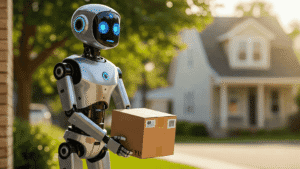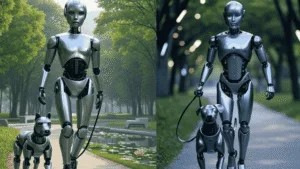Amazon’s Delivery Robots: Revolutionizing the Last Mile of Delivery

In today’s fast-paced world, speed and efficiency are not just appreciated—they’re expected. With e-commerce booming and same-day deliveries becoming the norm, Amazon has taken a bold step into the future of logistics: delivery robots. These compact, autonomous machines are transforming how packages travel that “last mile” to your doorstep.
What Are Amazon’s Delivery Robots?
Amazon’s delivery robots, known as Amazon Scout, are six-wheeled, cooler-sized autonomous robots designed to safely navigate sidewalks and deliver packages directly to customers. Introduced in 2019, these robots have been quietly tested in a few neighborhoods across the United States, including parts of California and Washington.
How Do They Work?
Equipped with sensors, cameras, and GPS, Amazon Scout can:
Avoid obstacles like pets, pedestrians, and traffic,
Follow mapped routes on sidewalks,
Stop at crosswalks and resume safely,
Communicate with customers via the Amazon app.
When Scout arrives at its destination, customers receive a notification. They can then step outside and unlock the robot’s lid using their phone to retrieve their package.
The Goal: Solving the Last-Mile Problem
The last mile—the final leg of the delivery journey from a local hub to the customer’s door—is one of the most expensive and complex parts of logistics. Traffic congestion, delivery time windows, and labor costs make it a logistical challenge.
Delivery robots like Scout aim to:
Reduce delivery costs,
Ease the burden on human drivers,
Minimize carbon emissions,
Offer safer, contactless delivery options.
Real-World Testing and Results
Amazon has deployed Scout in limited regions with human assistants initially monitoring the robots. These pilots help test:
Robot behavior in varying weather conditions,
Interaction with people and pets,
Overall reliability in busy suburban areas.
Feedback from these tests has helped Amazon improve the robots’ software and hardware, leading to more advanced prototypes.
Challenges and Limitations
Despite the promise, several challenges still exist:
Sidewalk access: Not all areas have smooth or connected pathways.
Weather sensitivity: Robots struggle in snow, heavy rain, or extreme heat.
Vandalism or theft: Some people may tamper with or damage the units.
Regulatory hurdles: Cities must approve sidewalk robots, which varies widely by location.
The Bigger Picture: Automation and Sustainability
Amazon’s delivery robots are part of a larger strategy that includes drones, AI-powered logistics, and electric delivery vans. Together, they reflect Amazon’s investment in automation, sustainability, and efficiency.
These robots are more than just delivery tools—they’re part of a larger vision of a smarter, greener logistics network that reduces dependence on fossil fuels and human labor for short-distance tasks.
Final Thoughts
Amazon’s delivery robots may still be in the experimental phase, but they symbolize a significant shift in the logistics industry. As technology matures and urban infrastructure adapts, we may soon see autonomous robots as a common sight in our neighborhoods—quietly, efficiently, and safely bringing your packages to your door.



